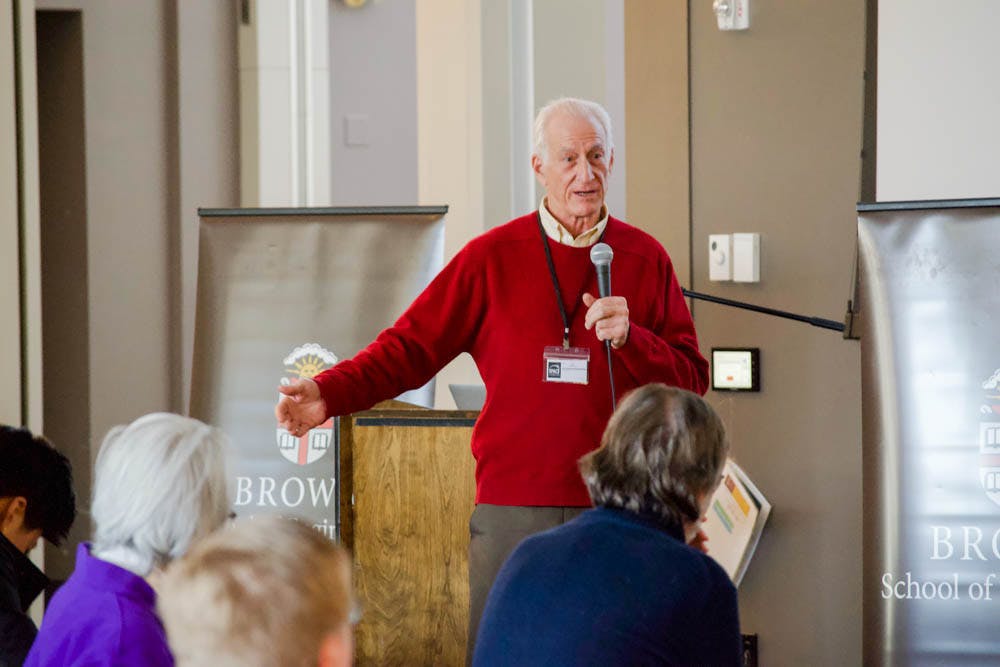In a seemingly endless expanse of darkness, planets orbit around shining stars and an invisible frontier awaits exploration, begging a number of questions: How far has prior knowledge guided us? How much further can latest advancements take us, and how long could we survive in space?
This year’s Space Horizons event, which took place Feb. 1 and 2 at the University, took a step toward answering these questions by gathering an array of speakers with expertise in space and the research essential to its exploration.
These presenters included former astronauts, scientific researchers, engineers and scholars of the humanities, said Adjunct Associate Professor of Engineering and co-organizer of the event Rick Fleeter ’76 PhD ’81. The conference was titled “A Century in Space: Designing 2056,” an homage to the hundred-year mark from the launch of Sputnik, Fleeter said.
Inspiring Figures: Astronauts, Space Biology, and Science Fiction
The two days involved a wide variety of speakers, including three experts who approached the idea of life beyond Earth from a range of perspectives and disciplines.
Jeff Hoffman, one of two former astronauts who spoke at the event, talked about his experience working on the Hubble Space Telescope and on new technology that has the potential to create oxygen in currently uninhabitable environments.
Hoffman has worked with the Mars Oxygen In-Situ Resource Utilization Experiment, which involves machinery that converts carbon dioxide into oxygen. Extracting these resources can be complex and hazardous. In-Situ Resource Utilization “is something that needs to be developed. We’re still at a very basic stage … MOXIE is just the very first, very tiny experiment. There is much more that has to be done,” Hoffman said. MOXIE machinery will be attached to an upcoming planned Mars rover, which should reach the red planet February 2021.
While the prospect of colonizing space may seem like a fantasy to some, Adjunct Professor of Molecular Biology, Cell Biology and Biochemistry Lynn Rothschild PhD ’85, discussed the potential applications of synthetic biology to supporting the existence of life beyond Earth. As the principal investigator for the PowerCell payload and a member of the team on the Eu:CROPIS mission, which is the “first dedicated satellite synthetic biology mission,” she helped conduct biological experiments on a satellite in space, testing cell growth rate and other processes. These tests allowed the team to examine how gravity on a different planet or in space would affect Earth life forms.
The Eu:CROPIS mission also tested the concept of PowerCells, which involves microbes — specifically, ruptured cyanobacteria — that produce energy; other organisms could theoretically use that energy to produce oxygen or other resources. A Brown-Stanford International Genetically Engineered Machine Competition team initiated this concept in 2011, The Herald previously reported. “If you have a synthetic-biology enabled colony on Mars,” PowerCells and related organisms could become the “biological power center” for human life in that colony, Rothschild said.
While Rothschild anticipated some success from the mission, she was “absolutely shocked when it (looked) like something (was) actually happening … for every one of (the experiments).”
In the end, she thinks the application of synthetic biology can be “a totally different way of thinking” and “has the potential to be the big game-changer” in the space field.
Finally, speaker Allen Steele, a science fiction author, reminded attendees that humanity’s relationship to space has historically been inspired by outlandish and fictional ideas. He argued that ideas presented in fictional literature can serve as jumping-off points for others who may be able to turn those concepts into reality.
2056: The Incoming Generation of Astro-Scientists
The potential for new developments in space exploration within the next 50 years was a recurring theme of the event, said Asutosh Swain ’20, one of the student organizers of the event and the research and development lead of Brown Space Engineering. Swain’s group built and launched the EQUiSat satellite last spring, The Herald previously reported.
Other goals for the conference included “giving students a perspective on where their careers are (going to) most likely be centered” and allowing professionals to reflect on past accomplishments, as well as providing a glimpse into what could be in store for the future, Fleeter said.
“There are exciting things going on up there that … you as a student can be a part of. So, get down and come up with some innovative ideas that will allow us to do things that up to now have been too hard,” Hoffman said, adding that the future holds “a new generation of people with new ideas, and we’ve got to make it happen.”
Swain added that no one has to be a scientific expert to join in on the action. “Space is accessible to even the general public. You don’t have to be a scientist at NASA” or “an aerospace engineer, specifically, to be involved with this.” Ugo Piovan ’22 attended the event because he “really (enjoys) aerospace engineering and the whole concept of exploring other worlds” and was likewise excited to see the astronauts speak, as well as hear from Rothschild about the biological science behind space. Specifically, Rothschild’s graphs depicting results from the experiments were an aspect he “found … very interesting and easy to understand,” he added.
Clarification: An earlier version of this article stated that Lynn Rothschild PhD ’85 helped conduct biological experiments on a satellite in space, testing cell growth rate and other processes as a member of the team on the Eu:CROPIS mission. In addition, Rothschild is the Principal Investigator for the PowerCell payload. The Herald regrets the error.





